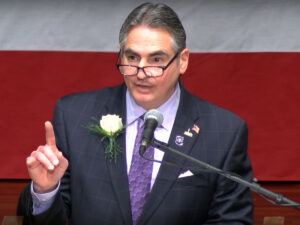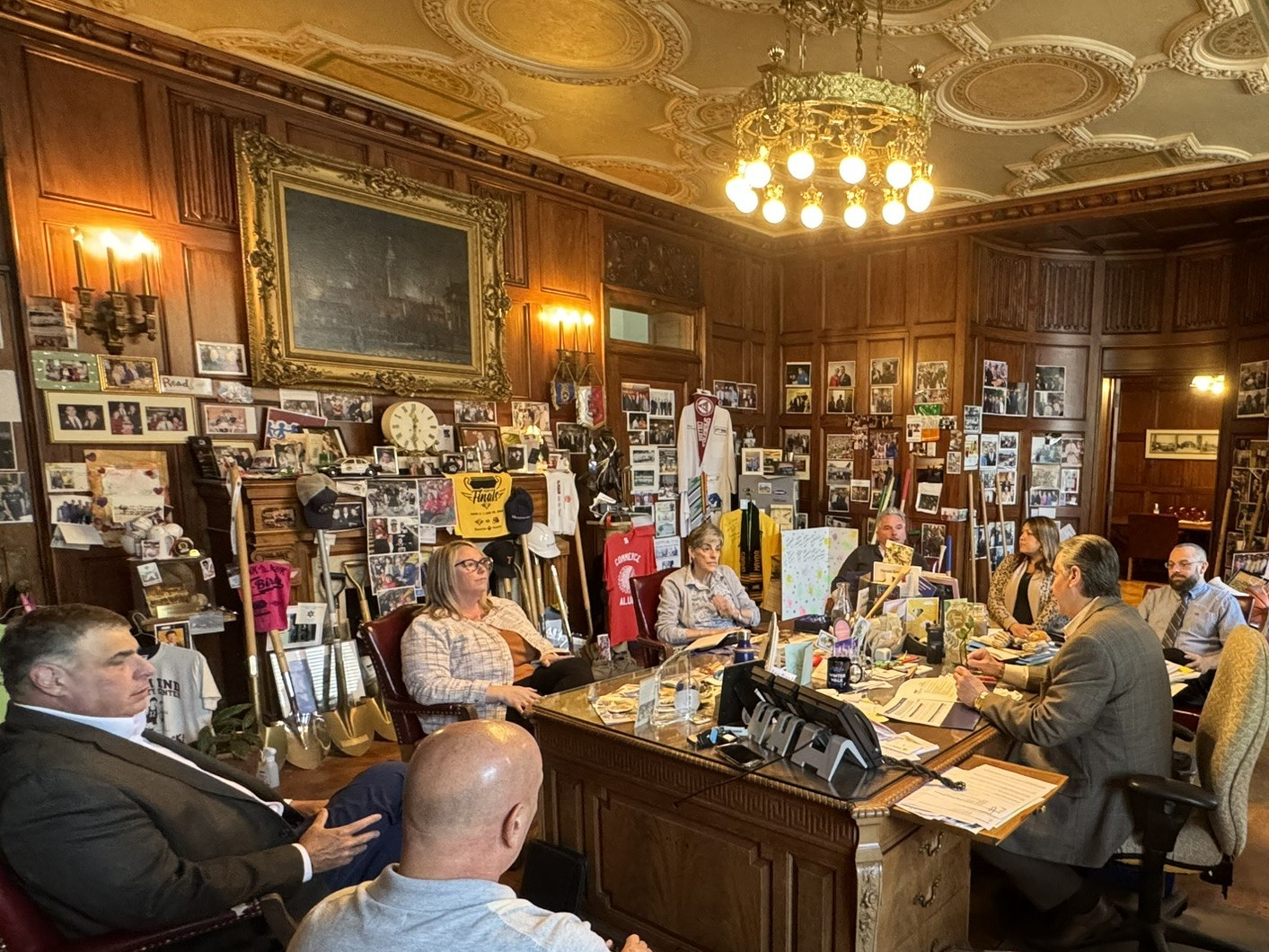Analysis: A Year after Feud, Sarno Needs Amtrak As Other Economic Feats Lose Steam…
Amid the stream of mayoral photos on the misnamed City of Springfield Office of Communications Facebook page—it is actually just the mayor’s office—was a curious post earlier this month. It was a meeting that would have been unimaginable 11 months ago. Mayor Domenic Sarno and members of his cabinet had met with government affairs staff from Amtrak. Last June, Sarno was at war with the railroad.
Back then, the mayor was inveighing against Amtrak, calling it everything but a child of God, for not allowing the opening of the State Street crossing, or at least not at a reasonable price. The matter did reach resolution, however. Still, the episode stands out because the mayor may now need Amtrak—and rail service generally—more than ever as the pillars of the mayor’s economic record sag.
As early 2019, Springfield pundits had observed the mayor’s economic program amounted to three things. Two were essentially completed: MGM’s casino and Union Station. The third, redeveloping the Court Square building, finally reached completion this year. A fourth part, the CRRC railcar factory, was a state initiative, but has been a lower-profile element of his economic program.
Springfield is fiscally sound now, but commercial property values have stagnated as residential values leap upward. That has put a strain on homeowners while exposing the budget should a correction occur. The mayor’s economic tentpoles could provide a solution were they to reach their full potential.
Unfortunately for Sarno, the casino and the railcar plant face doubts. Bloomberg reported this year that MGM is considering a sale. Such rumors have bubbled up almost from the moment the doors opened. They do seem more serious now. Meanwhile, CRRC has no clear future after the MBTA’s contract ends. Warning lights came on after Congress barred the use of federal funds for future railcars prefabricated in China. Then CRRC lost its contract for Philadelphia’s transit agency.
On MGM, the mayor has insisted, correctly, that the city has leverage. Plus, a buyer would need to accept the host community agreement and receive state approval. Yet, these are not trump cards. Plus, declarations about that leverage may also be an admission the city is on the back foot on this matter.
Meanwhile, the Court Square apartments are available to rent, but it is no longer an active driver of jobs. Completion of the project came only after heavy subsidies, something that proposals for other nearby blocks may need. At a time when skyrocketing real estate prices have put pressure on residential tax bills, the Court Square building’s formula may not find a receptive audience in the City Council.
Enter Amtrak.
Any city of Springfield’s size would likely have a love-hate relationship with Amtrak. Rail service is popular with the public and politicians. On the other hand, a railroad requires a lot of infrastructure. As a de facto federal agency, it tends to lumber on with its mission and objectives absent strong outside political pressure. That can create conflicts. Springfield public works officials have grumbled about the railroad’s responsiveness to issues arising along their right-of-way.
In one such case, the conflicts culminated in a license agreement that largely closed the State Street grade crossing into Riverfront Park. Few grade crossings still exist in Springfield. Most are industrial sidings. With the de facto State Street closure, Amtrak has no public crossings in Springfield.
Last year, Sarno was hollering at the railroad. On June 30, he alleged Amtrak had refused to open the crossing for fireworks spectators to access Riverfront Park. This was the same day that an Amtrak spokesperson later said the Spirit of Springfield, which puts on the fireworks, completed its agreement to use the State Street crossing. Amtrak’s public comments at the time indicated it had not denied the use of the crossing. Rather, to ensure public safety, it restricted usage to before and after the fireworks.

Shorter Sarno last year to Amtrak: Don’t make me wag my finger at you! (Still via Focus Springfield)
After some limb-flailing on Sarno’s part, including filing complaints with agencies with no jurisdiction over Amtrak, others reached a breakthrough. Congressman Richard Neal and others, via channels to Transportation Secretary Pete Buttigieg, found a way to invert the original crossing plan. It would stay open the evening of July 4 but shut periodically for scheduled trains.
As Amtrak had participated in earlier planning meetings and, given the timing of the agreements, the whole situation appears to have been a miscommunication between the railroad and the Spirit of Springfield. Nevertheless, the mayor went on full blast, accusing Amtrak of denying access to public space. That was not true. Moreover, the mayor himself signed the agreement that largely closed the State Street crossing and required deals like the Spirit of Springfield’s.
But Amtrak, like most federal agencies, does not hold grudges and now Sarno needs it.
Flush with funds for several years under President Joe Biden’s Infrastructure Investment and Jobs Act—often hand-in-hand with a state that also has cash—there is a lot on the drawing board for Springfield. Aside from Compass Rail, nee East-West Rail—many of these projects are about flexibility and reliability. Invaluable to passengers but not necessarily, ahem, “gamechangers” by themselves.
Rail investments could greatly benefit Springfield. Ongoing service expansion south into Connecticut, New York and beyond increasingly seem limited only by Amtrak’s equipment availability. Service to Boston and Albany hinge less on money and more on bureaucratic speed. More service north is also on the menu depending on choices Vermont, or even Canada, make.
Worcester illustrates the potential. In the last census, the Woo exceeded its peak population thanks in part to expanding commuter rail service from Boston. Most new service into Springfield will not be commuter rail. Even the one commuter line into the city, the Hartford Line, functions more as a feeder to Metro-North in New Haven. Nevertheless, it is reasonable that expanding service could provide a long-term boon for the city.
A spokesperson for the mayor did not respond to a request for comment about the meeting. His office’s Facebook post said the heads of the city’s parks, public works and economic development departments attended. Sarno thanked Amtrak for the meeting with Joan Brophy and Margaret Clark, the railroad’s Northeast Government Affairs Director and Manager respectively, and the updates they provided about area projects.
“We also discussed Riverfront Park access, and separate entrance points, and Union Station developments. Transit investments support local economic growth and we are looking forward to continued collaboration with Amtrak,” Sarno said.

The mayor catching up with Amtrak’s Brophy & Clark from Gov’t Affairs like they’re old friends…but Amtrak may become an economically indispensable friend. (via Facebook/Springfield City Hall)
An Amtrak spokesperson had no updates on the projects, but characterized the visit as a “high-level meet and greet meeting.”
Sarno has never downplayed Union Station, but with little direct influence over service, he cannot do much more than treat the transportation hub like a prop to stand in front of and look mayoral. Exceptions would be the $4.1 million grant Congressman Richard Neal, the station’s chief patron, and Sarno announced last week. It will fund improvements to roads, sidewalks, and lighting, with a focus on greener, more sustainable infrastructure.
However, at least since former State Senator Eric Lesser made East-West rail a shibboleth in the 413’s politics, Neal has pressed every button he could to make that service happen. He had been pushing for North-South service for longer. Union Station has been central to his political identity since his first campaign. Yet, he also understood that it was not just a backdrop. The arm-twisting he engaged in was not always public.
Despite always touting a great relationship with former Governor Charlie Baker, it is not clear Sarno ever had any influence on East-West rail. (By contrast, current Governor Maura Healey, both on her own initiative and in tandem with Neal, is all in on the project.)
The pandemic and the American Rescue Plan Act’s funds allowed Sarno to shirk the absence of many new ideas during last year’s election—hair-brained paeans to motorcoach moguls aside. In short, he could sidestep the quiet mutters from back in 2019 that he had few new things to plug. That will be less true should the eternal mayor seek another term in 2027.

